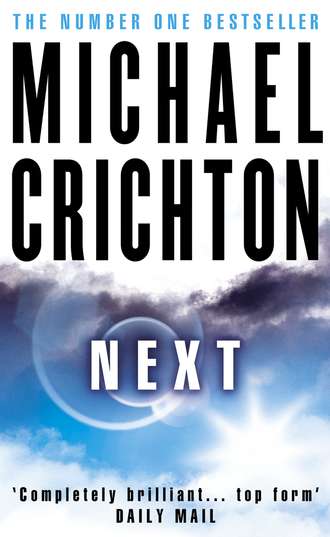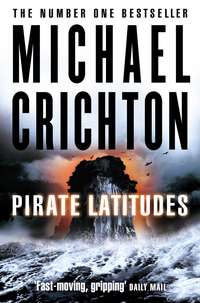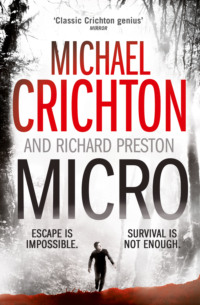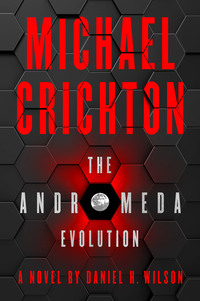
Полная версия
Next
Her father stared at them, thunderstruck. “Are you joking?”
“No, Mr. Burnet. It’s a legitimate taking, and the state will exercise its right.”
Alex said, “Then what is the purpose of this meeting?”
“We thought it appropriate to inform you of the situation, in case you wanted to drop further litigation.”
“You’re suggesting we end litigation?” she said.
“I would advise it,” Rodriguez said to her, “if this were my client.”
“Ending litigation saves the state considerable expense.”
“It saves everyone expense,” Rodriguez said.
“So what are you proposing as a settlement, for us to drop the case?”
“Nothing whatever, Ms. Burnet. I’m sorry if you misunderstood me. This is not a negotiation. We’re simply here to explain our position, so that you can make an informed decision in your best interest.”
Her father cleared his throat. “You’re telling us that you’re taking my cells, no matter what. You’ve sold them for three billion dollars, no matter what. And you’re keeping all of that money, no matter what.”
“Bluntly put,” Rodriguez said, “but not inaccurate.”
The meeting ended. Rodriguez and his team thanked them for their time, said their good-byes, and left the room. Alex nodded to her father and then followed the other attorneys outside. Through the glass, Frank Burnet watched as they talked further.
“Those fuckers,” he said. “What kind of world do we live in?”
“My sentiments exactly,” said a voice from behind him. Burnet turned.
A young man wearing horn-rimmed glasses was sitting in the far corner of the conference room. Burnet remembered him; he had come in during the meeting, bringing coffee and mugs, which he had put on the sideboard. Then he had sat down in the corner for the rest of the meeting. Burnet had assumed he was a junior member of the firm, but now the young man was speaking with confidence.
“Let’s face it, Mr. Burnet,” he said, “you’ve been screwed. It turns out your cells are very rare and valuable. They’re efficient manufacturers of cytokines, chemicals that fight cancer. That’s the real reason you survived your disease. As a matter of fact, your cells churn out cytokines more efficiently than any commercial process. That’s why those cells are worth so much money. The UCLA doctors didn’t create anything or invent anything. They didn’t genetically modify anything. They just took your cells, grew them in a dish, and sold the dish to BioGen. And you, my friend, were screwed.”
“Who are you?” Burnet said.
“And you have no hope of justice,” the young man continued, “because the courts are totally incompetent. The courts don’t realize how fast things are changing. They don’t understand we are already in a new world. They don’t get the new issues. And because they are technically illiterate, they don’t understand what procedures are done—or in this case, not done. Your cells were stolen and sold. Plain and simple. And the court decided that was just fine.”
Burnet gave a long sigh.
“But,” the man continued, “thieves can still get their comeuppance.”
“How’s that?”
“Because UCLA did nothing to change your cells, another company could take those same cells, make minor genetic modifications, and sell them as a new product.”
“But BioGen already has my cells.”
“True. But cell lines are fragile. Things happen to them.”
“What do you mean?”
“Cultures are vulnerable to fungus, bacterial infection, contamination, mutation. All kinds of things can go wrong.”
“BioGen must take precautions…”
“Of course. But sometimes the precautions are inadequate,” the man said.
“Who are you?” Burnet said again. He was looking around, through the glass walls of the conference room, at the larger office outside. He saw people walking back and forth. He wondered where his daughter had gone.
“I’m nobody,” the young man said. “You never met me.”
“You have a business card?”
The man shook his head. “I’m not here, Mr. Burnet.”
Burnet frowned. “And my daughter—”
“Has no idea. Never met her. This is between us.”
“But you’re talking about illegal activity.”
“I’m not talking at all, because you and I have never met,” the man said. “But let’s consider how this might work.”
“Okay…”
“You can’t legally sell your cells at this point, because the court has ruled you no longer own them—BioGen does. But your cells could be obtained from other places. Over the course of your life, you’ve given blood many times in many places. You went to Vietnam forty years ago. The army took your blood. You had knee surgery twenty years ago in San Diego. The hospital took your blood, and kept your cartilage. You’ve consulted various doctors over the years. They ran blood tests. The labs kept the blood. So your blood can be found, no problem. And it can be acquired from publicly available databases—if, for example, another company wanted to use your cells.”
“And what about BioGen?”
The young man shrugged. “Biotechnology is a difficult business. Contaminations happen every day. If something goes wrong in their labs, that’s not your problem, is it?”
“But how could—”
“I have no idea. So many things can happen.”
There was a short silence. “And why should I do this?” Burnet said.
“You’ll get a hundred million dollars.”
“For what?”
“Punch biopsies of six organ systems.”
“I thought you could get my blood elsewhere.”
“In theory. If it came to litigation, that would be claimed. But, in practice, any company would want fresh cells.”
“I don’t know what to say.”
“No problem. Think it over, Mr. Burnet.” The young man stood, pushed his glasses up his nose. “You may have been screwed. But there’s no reason to bend over for it.”
From Beaumont College Alumni News
STEM CELL DEBATE RAGES
Effective Treatments “Decades Away” Prof. McKeown Shocks Audience
By Max Thaler
Speaking to a packed audience in Beaumont Hall, famed biology professor Kevin McKeown shocked listeners by calling stem cell research “a cruel fraud.”
“What you have been told is nothing more than a myth,” he said, “intended to ensure funding for researchers, at the expense of false hopes for the seriously ill. So let’s get to the truth.”
Stem cells, he explained, are cells that have the ability to turn themselves into other kinds of cells. There are two kinds of stem cells. Adult stem cells are found throughout the body. They are found in muscle, brain, and liver tissue, and so on. Adult stem cells can generate new cells, but only of the tissue in which they are found. They are important because the human body replaces all its cells every seven years.
Research involving adult stem cells is for the most part not controversial. But there is another kind of stem cell, the embryonic stem cell, that is highly controversial. It is found in umbilical cord blood, or derived from young embryos. Embryonic stem cells are pluripotent, meaning they can develop into any kind of tissue. But the research is controversial because it involves the use of human embryos, which many people feel, for religious and other reasons, have the rights of human beings. This is an old debate not likely to be resolved soon.
SCIENTISTS SEE A BAN ON RESEARCH
The current American administration has said that embryonic stem cells can be taken from existing research lines, but not from new embryos. Scientists regard existing lines as inadequate, and thus view the ruling a de facto ban on research. That’s why they are going to private centers to carry out their research, without federal grants.
But in the end, the real problem isn’t simply a lack of stem cells. It’s the fact that in order to produce therapeutic effects, scientists need each person to have his or her own pluripotent stem cells. This would allow us to regrow an organ, or to repair damage from injury or disease, or to undo paralysis. This represents the great dream. No one is able to perform these therapeutic miracles now. No one even has an inkling how it might be done. But it requires the cells.
Now, for newborns, you can collect umbilical cord blood and freeze it, and people are doing that with their newborns. But what about adults? Where will we get pluripotent stem cells?
That’s the big question.
TOWARD THE THERAPEUTIC DREAM
All we adults have left is adult stem cells, which can make only one kind of tissue. But what if there were a way to convert adult stem cells back into embryonic stem cells? Such a procedure would enable every adult to have a ready source of his or her own embryonic stem cells. That would make the therapeutic dream possible.
Well, it turns out that you can reverse adult stem cells, but only if you insert them into an egg. Something within the egg unwinds the differentiation and converts the adult stem cell back into an embryonic stem cell. This is good news, but it is vastly more difficult to do with human cells. And if the method could be made to work in human beings, it would require an enormous supply of human egg cells. That makes the procedure controversial again.
So scientists are looking for other ways to make adult cells pluripotent. It is a worldwide effort. A researcher in Shanghai has been injecting human stem cells into chicken eggs, with mixed results—while others cluck in disapproval. It’s not clear now whether such procedures will work.
It’s equally unclear whether the stem cell dream—transplants without rejection, spinal cord injuries repaired, and so on—will come true. Advocates have made dishonest claims, and media speculation has been fantastical for years. People with serious illnesses have been led to believe a cure is just around the corner. Sadly, this is not true. Working therapeutic approaches lie many years in the future, perhaps decades. Many thoughtful scientists have said, in private, that we won’t know whether stem cell therapy will work until 2050. They point out that it took forty years from the time Watson and Crick decoded the gene until human gene therapy began.
A SCANDAL SHOCKS THE WORLD
It was in the context of feverish hope and hype that Korean biochemist Hwang Woo-Suk announced in 2004 that he had successfully created a human embryonic stem cell from an adult cell by somatic nuclear transfer—injection into a human egg. Hwang was a famous workaholic, spending eighteen hours a day, seven days a week, in the lab. Hwang’s exciting report was published in March 2005 in Science magazine. Researchers from around the world flocked to Korea. Human stem cell treatment seemed suddenly on the verge of reality. Hwang was a hero in Korea, and appointed to head a new World Stem Cell Hub, financed by the Korean government.
But in November 2005, an American collaborator in Pittsburgh announced that he was ending his association with Hwang. And then one of Hwang’s co-workers revealed that Hwang had obtained eggs illegally, from women who worked in his lab.
By December 2005, Seoul National University announced that Hwang’s cell lines were a fabrication, as were his papers in Science. Science retracted the papers. Hwang now faces criminal charges. There the matter stands.
PERILS OF “MEDIA HYPE”
“What lessons can be drawn from this?” asked Professor McKeown. “First, in a media-saturated world, persistent hype lends unwarranted credulity to the wildest claims. For years the media have touted stem cell research as the coming miracle. So when somebody announced that the miracle had arrived, he was believed. Does that imply there is a danger in media hype? You bet. Because not only does it raise cruel hopes among the ill, it affects scientists, too. They start to believe the miracle is around the corner—even though they should know better.
“What can we do about media hype? It would stop in a week, if scientific institutions wanted that. They don’t. They love the hype. They know it brings grants. So that won’t change. Yale, Stanford, and Johns Hopkins promote hype just as much as Exxon or Ford. So do individual researchers at those institutions. And increasingly, researchers and universities are all commercially motivated, just like corporations. So whenever you hear a scientist claim that his statements have been exaggerated, or taken out of context, just ask him if he has written a letter of protest to the editor. Ninety-nine times out of a hundred, he hasn’t.
“Next lesson: Peer review. All of Hwang’s papers in Science were peer-reviewed. If we ever needed evidence that peer review is an empty ritual, this episode provides it. Hwang made extraordinary claims. He did not provide extraordinary evidence. Many studies have shown that peer review does not improve the quality of scientific papers. Scientists themselves know it doesn’t work. Yet the public still regards it as a sign of quality, and says, ‘This paper was peer-reviewed,’ or ‘This paper was not peer-reviewed,’ as if that meant something. It doesn’t.
“Next, the journals themselves. Where was the firm hand of the editor of Science? Remember that the journal Science is a big enterprise—115 people work on that magazine. Yet gross fraud, including photographs altered with Adobe Photoshop, were not detected. And Photoshop is widely known as a major tool of scientific fraud. Yet the magazine had no way to detect it.
“Not that Science is unique in being fooled. Fraudulent research has been published in the New England Journal of Medicine, where authors withheld critical information about Vioxx heart attacks; in the Lancet, where a report about drugs and oral cancer was entirely fabricated—in that one, 250 people in the patient database had the same birth date! That might have been a clue. Medical fraud is more than a scandal, it’s a public health threat. Yet it continues.”
THE COST OF FRAUD
“The cost of such fraud is enormous,” McKeown said, “estimated at thirty billion dollars annually, probably three times that. Fraud in science is not rare, and it’s not limited to fringe players. The most respected researchers and institutions have been caught with faked data. Even Francis Collins, the head of NIH’s Human Genome Project, was listed as co-author on five faked papers that had to be withdrawn.
“The ultimate lesson is that science isn’t special—at least not anymore. Maybe back when Einstein talked to Niels Bohr, and there were only a few dozen important workers in every field. But there are now three million researchers in America. It’s no longer a calling, it’s a career. Science is as corruptible a human activity as any other. Its practitioners aren’t saints, they’re human beings, and they do what human beings do—lie, cheat, steal from one another, sue, hide data, fake data, overstate their own importance, and denigrate opposing views unfairly. That’s human nature. It isn’t going to change.”
CH008
In the BioGen animal lab, Tom Weller was going down the line of cages with Josh Winkler, who was dispensing doses of gene-laced virus to the rats. It was their daily routine. Tom’s cell phone rang.
Josh gave him a look. Josh was his senior. Josh could take calls at work, but Tom couldn’t. Weller stripped off one rubber glove and pulled the phone from his pocket.
“Hello?”
“Tom.”
It was his mother. “Hi, Mom. I’m at work now.”
Josh gave him another look.
“Can I call you back?”
“Your dad had a car accident last night,” she said. “And…he died.”
“What?” He felt suddenly dizzy. Tom leaned against the rat cages, took a shallow breath. Now Josh was giving him a concerned look. “What happened?”
“His car hit an overpass around midnight,” his mother said. “They took him to Long Beach Memorial Hospital, but he died early this morning.”
“Oh God. Are you at home?” Tom said. “You want me to come over? Does Rachel know?”
“I just got off the phone.”
“Okay, I’ll come over,” he said.
“Tom, I hate to ask you this,” she said, “but…”
“You want me to tell Lisa?”
“I’m sorry. I can’t seem to reach her.” Lisa was the black sheep of the family. The youngest child, just turned twenty. Lisa hadn’t talked to her mother in years. “Do you know where she is these days, Tom?”
“I think so,” he said. “She called a few weeks ago.”
“To ask for money?”
“No, just to give me her address. She’s in Torrance.”
“I can’t reach her,” his mother said.
“I’ll go,” he said.
“Tell her the funeral is Thursday, if she wants to come.”
“I’ll tell her.”
He flipped the phone shut and turned to Josh. Josh was looking concerned and sympathetic. “What was it?”
“My father died.”
“I’m really sorry…”
“Car crash, last night. I need to go tell my sister.”
“You have to leave now?”
“I’ll stop by the office on my way out and send Sandy in.”
“Sandy can’t do this. He doesn’t know the routine—”
“Josh,” he said, “I have to go.”
Traffic was heavy on the 405. It took almost an hour before he found himself in front of a ratty apartment building on South Acre in Torrance, pushing the buzzer for apartment 38. The building stood close to the freeway; the roar of traffic was constant.
He knew Lisa worked nights, but it was now ten o’clock in the morning. She might be awake. Sure enough, the buzzer sounded, and he opened the door. The lobby smelled strongly of cat piss. The elevator didn’t work, so he took the stairs to the third floor, stepping around plastic sacks of garbage. A dog had broken one sack open, and the contents spilled down a couple of steps.
He stopped in front of apartment 38, pushed the doorbell. “Just a fucking minute,” his sister called. He waited. Eventually, she opened the door.
She was wearing a bathrobe. Her short black hair was pulled back. She looked upset. “The bitch called,” she said.
“Mom?”
“She woke me up, the bitch.” She turned, went back into the apartment. He followed her. “I thought you were the liquor delivery.”
The apartment was a mess. Lisa padded into the kitchen, and poked around the pans and dishes stacked in the sink, found a coffee cup. She rinsed it out. “You want coffee?”
He shook his head. “Shit, Lise,” he said. “This place is a pigsty.”
“I work nights, you know that.”
She had never cared about her surroundings. Even as a child, her room was always a mess. She just didn’t seem to notice. Now Tom looked through the greasy drapes of the kitchen window at the traffic crawling past on the 405. “So. How’s work going?”
“It’s House of Pancakes. How do you think it’s going? Same every fucking night.”
“What did Mom say?”
“She wanted to know if I was coming to the funeral.”
“What’d you say?”
“I told her to fuck off. Why should I go? He wasn’t my father.”
Tom sighed. This was a long-standing argument within the family. Lisa believed she was not John Weller’s daughter. “You don’t think so, either,” she said to Tom.
“Yeah, I do.”
“You just say whatever Mom wants you to say.” She fished out a cigarette butt from a heaping ashtray, and bent over the stove to light it from the burner. “Was he drunk when he crashed?”
“I don’t know.”
“I bet he was shitfaced. Or on those steroids he used, for his bodybuilding.”
Tom’s father had been a bodybuilder. He took it up later in life, and even competed in amateur contests. “Dad didn’t use steroids.”
“Oh sure, Tom. I used to look in his bathroom. He had needles.”
“Okay, so you didn’t like him.”
“It doesn’t matter anymore,” she said. “He wasn’t my father. I don’t care about any of it.”
“Mom always said that he was your father, that you were just saying it, because you didn’t like him.”
“Well, guess what? We can settle it, once and for all.”
“How do you mean?”
“I mean, a paternity test.”
“Lisa,” he said. “Don’t start this.”
“I’m not starting. I’m finishing.”
“Don’t. Promise me you won’t do this. Come on. Dad’s dead, Mom’s upset, promise me.”
“You are a chickenshit pussy, you know that?” That was when he saw she was near tears.
He put his arms around her, and she began to cry. He just held her, feeling her body shake. “I’m sorry,” she said. “I’m so sorry.”
After her brother had gone, she heated a cup of coffee in the microwave, then sat down at the kitchenette table by the phone. She dialed Information. She got the number for the hospital. A moment later, she heard the receptionist say, “Long Beach Memorial.”
“I want to talk to the morgue,” she said.
“I’m sorry. The morgue is at the County Coroner’s Office. Would you like that number?”
“Someone in my family just died at your hospital. Where would his body be now?”
“One moment please, I will connect you to pathology.”
Four days later, her mother called back. “What the hell do you think you’re doing?”
“What do you mean?”
“I mean, going down to the hospital and asking for blood from your father.”
“He’s not my father.”
“Lisa. Don’t you ever get tired of this game?”
“No, and he’s not my father, because the genetic tests came back negative. It says right here”—she reached for the printed sheet—“that there is less than one chance in 2.9 million that John J. Weller is my father.”
“What genetic test?”
“I had a genetic test done.”
“You’re so full of shit.”
“No, Mom. You’re the one who’s full of shit. John Weller’s not my father, and the test proves it. I always knew it.”
“We’ll see about that,” her mother said, and hung up.
About half an hour after that, her brother, Tom, called. “Hey, Lise.” Real casual, laid-back.
“Just got a call from Mom.”
“Yeah?”
“She said something about a test?”
“Yeah. I did a test, Tommy. And guess what?”
“I heard. Who did this test, Lise?”
“A lab here in Long Beach.”
“What’s it called?”
“BioRad Testing.”
“Uh-huh,” her brother said. “You know, these labs that advertise on the Internet aren’t very reliable. You know that, don’t you?”
“They guaranteed it.”
“Mom’s all upset.”
“Too bad,” she said.
“You know she’ll do her own test now? And there’s going to be lawsuits? Because you’re accusing her of infidelity.”
“Gee, Tommy, I don’t really give a damn. You know that?”
“Lise, I think this is causing a lot of needless trouble around Dad’s death.”
“Your dad,” she said. “Not mine.”
CH009
Kevin McCormick, chief administrator of Long Beach Memorial, looked up at the chubby figure coming into his office, and said, “How the hell did this happen?” He pushed a sheaf of papers across his desk.
Marty Roberts, the chief of pathology, glanced quickly through the document. “I have no idea,” he said.
“The wife of the deceased, Mr. John J. Weller, is suing us for unauthorized release of tissue to the daughter.”
“What’s the legal situation?” Marty Roberts said.
“Unclear,” McCormick said. “Legal says the daughter is a family member and has a clear right to be given tissues to test for diseases that may affect her. Problem is, she did a paternity test and it came back negative. So she’s not his daughter. Arguably that makes our release of tissues unauthorized.”
“We couldn’t have known that at the time—”
“Of course not. But we’re talking about the law. The only important question is, can the family sue? The answer is yes, they have grounds to bring a suit, and they are.”
“Where’s the body now?” Marty said.
“Buried. Eight days ago.”
“I see.” Marty flipped through the pages. “And they are asking for…”
“Besides unspecified damages, they’re asking for blood and tissue samples to conduct further testing,” McCormick said. “Do we have blood or tissue samples from the deceased?”
“I’d have to check,” Marty said. “But I’d presume that we do, yes.”







